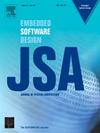激光雷达定位使用位置编码的地标,没有点云图
IF 4.1
2区 计算机科学
Q1 COMPUTER SCIENCE, HARDWARE & ARCHITECTURE
引用次数: 0
摘要
基于激光雷达的定位在自动驾驶和机器人导航中起着至关重要的作用。然而,传统的方法严重依赖于构建高精度的点云图,这既耗时又费力。为了解决这个问题,我们提出了一种创新的定位方法,通过利用激光雷达和位置编码地标来消除对点云图的需求。我们的方法将位置信息编码成特别设计的地标的形状,策略性地部署在环境中。随后,我们充分利用激光雷达在精确测量距离和捕获物体空间结构方面的优势,对环境中的地标进行检测和识别。通过解码嵌入在地标中的位置信息,实现精确的车辆定位。为了克服由于激光雷达在长距离时精度降低而导致的单个地标信息容量有限的问题,我们以协作的方式整合了多个地标。通过结合它们的编码信息和空间关系,我们可以在不依赖点云图的情况下实现高精度定位。在CARLA和Autoware中的实验。人工智能模拟器验证了我们方法的有效性,为基于激光雷达的定位提供了一种新颖的解决方案。本文章由计算机程序翻译,如有差异,请以英文原文为准。
LiDAR localization using position-encoded landmarks without point cloud maps
LiDAR-based localization plays a critical role in autonomous driving and robotic navigation. However, traditional methods rely heavily on constructing high-precision point cloud maps, which is both time-consuming and labor-intensive. To address this, we propose an innovative localization approach that eliminates the need for point cloud maps by leveraging LiDAR and position-encoded landmarks. Our method encodes positional information into the shape of specially designed landmarks, strategically deployed in the environment. Subsequently, we fully leverage the advantages of LiDAR in accurately measuring distances and capturing the spatial structures of objects to detect and recognize the landmarks in the environment. By decoding the positional information embedded in the landmarks, precise vehicle localization is achieved. To overcome the limited information capacity of individual landmarks due to LiDAR’s reduced accuracy at long distances, we integrate multiple landmarks in a collaborative manner. By combining their encoded information and spatial relationships, we achieve high-precision localization without relying on point cloud maps. Experiments in CARLA and Autoware.AI simulators validate the effectiveness of our approach, offering a novel solution for LiDAR-based localization.
求助全文
通过发布文献求助,成功后即可免费获取论文全文。
去求助
来源期刊

Journal of Systems Architecture
工程技术-计算机:硬件
CiteScore
8.70
自引率
15.60%
发文量
226
审稿时长
46 days
期刊介绍:
The Journal of Systems Architecture: Embedded Software Design (JSA) is a journal covering all design and architectural aspects related to embedded systems and software. It ranges from the microarchitecture level via the system software level up to the application-specific architecture level. Aspects such as real-time systems, operating systems, FPGA programming, programming languages, communications (limited to analysis and the software stack), mobile systems, parallel and distributed architectures as well as additional subjects in the computer and system architecture area will fall within the scope of this journal. Technology will not be a main focus, but its use and relevance to particular designs will be. Case studies are welcome but must contribute more than just a design for a particular piece of software.
Design automation of such systems including methodologies, techniques and tools for their design as well as novel designs of software components fall within the scope of this journal. Novel applications that use embedded systems are also central in this journal. While hardware is not a part of this journal hardware/software co-design methods that consider interplay between software and hardware components with and emphasis on software are also relevant here.
 求助内容:
求助内容: 应助结果提醒方式:
应助结果提醒方式:


